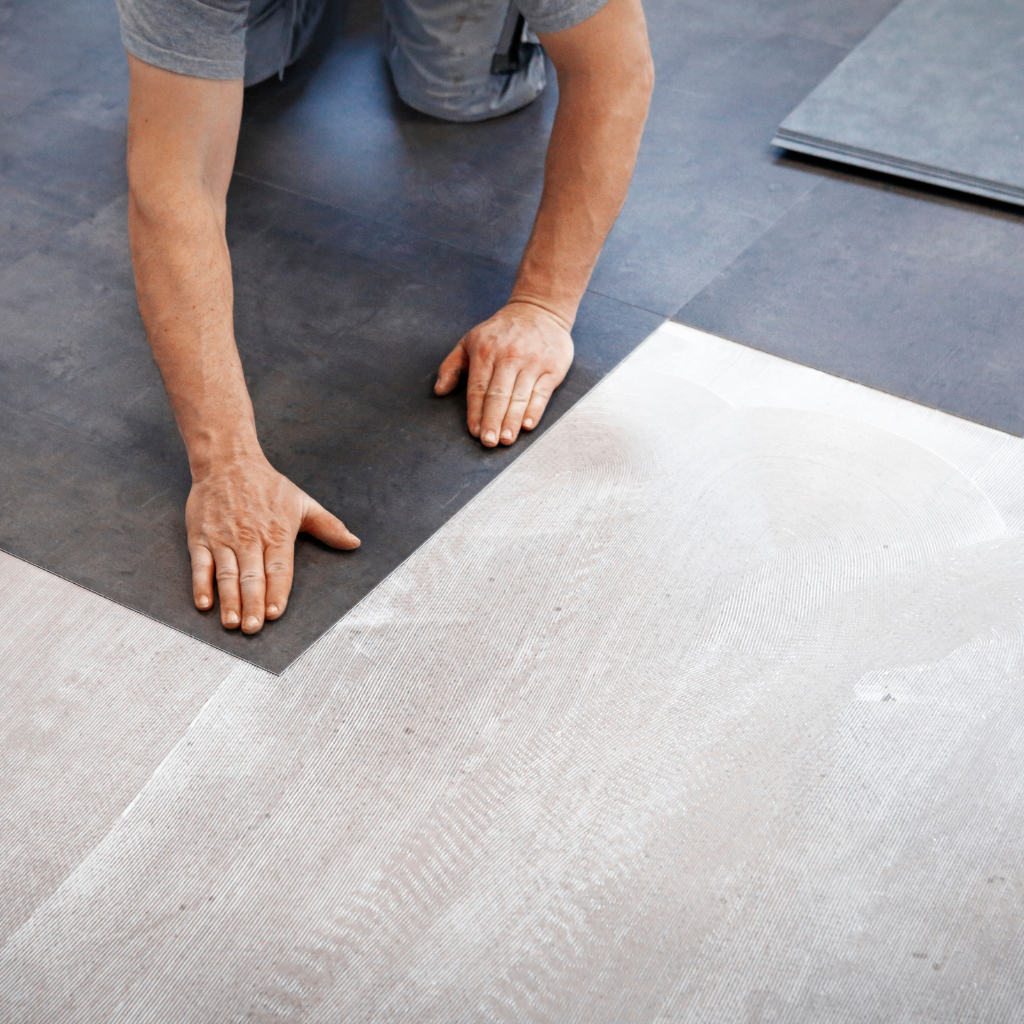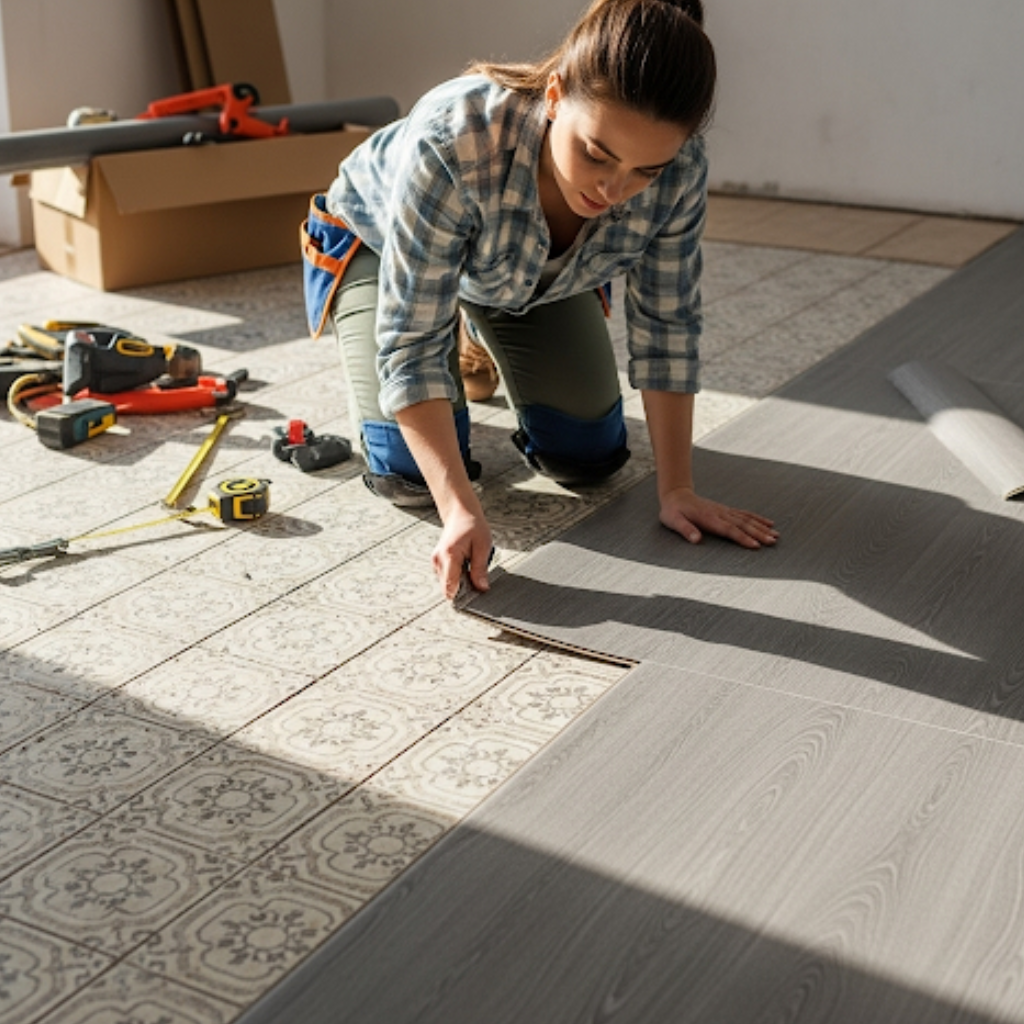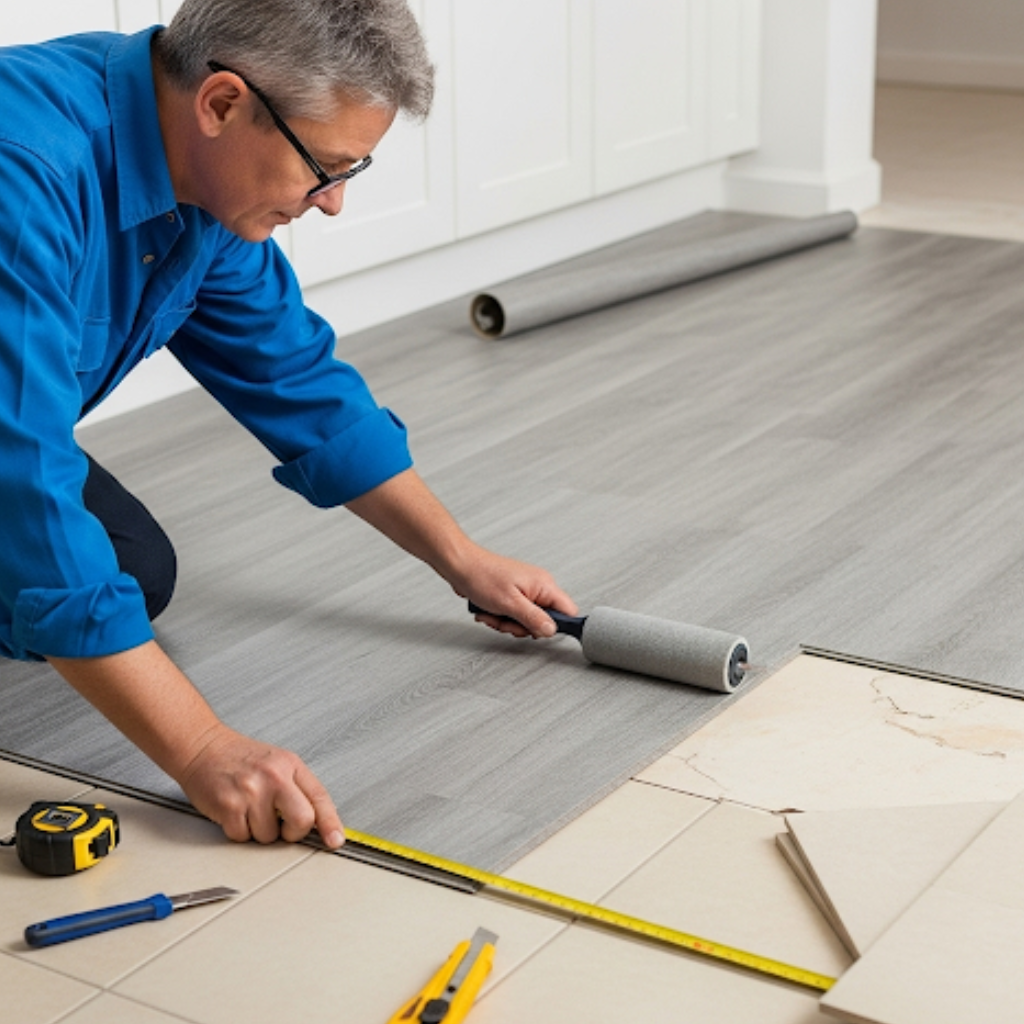Many homeowners pose the query, "can you put vinyl flooring over tiles?" The response is affirmative. Applying vinyl on existing tiles offers a swift and economical way to refresh your home's appearance without demanding extensive demolition or renovation.
This technique saves not just time but also funds, yielding an appealing finish that can rejuvenate any room.
Our family-managed company showcases years of experience in delivering superior flooring solutions straight to your premises. We take immense pride in providing a service that surpasses high street norms at more competitive prices.
Investigate how to augment your dwelling with luxury vinyl flooring over tiles surfaces. Find the optimal choices for a transformation that amalgamates elegance with functionality.
Before beginning your installation, it’s essential to familiarise yourself with some vinyl flooring basics to ensure the process runs smoothly. Preparing the tile surface before laying vinyl is crucial to ensure a successful installation. First, clean the tile floor thoroughly to remove all dust, debris, and dirt. Use a vacuum cleaner for loose particles, followed by mopping with a mild detergent solution.
This thorough cleaning prevents anything from interfering with the adhesion of the vinyl.
Once cleaned, inspect the tiles for damage or looseness. Repair any cracked tiles and ensure none are loose, as they could affect the new wood flooring's stability. If grout lines are deep or uneven, apply a thin layer of self-levelling compound over them to establish a flat surface for the vinyl flooring.
Allow this compound to dry completely, following the manufacturer's instructions before proceeding.
Ensuring your existing tile floor is clean and level forms the foundation of a standout vinyl flooring installation.
Surface preparation is vital for laying vinyl over tiles to ensure the new flooring adheres well and looks its best. Without proper preparation, imperfections in the tile can telegraph through the vinyl, creating a visually unappealing surface. Whether you're working with tile or laying vinyl tiles on wood, the same principle applies—thorough prep leads to smoother, longer-lasting results.
This step also prevents issues like cracks and wear over time, which could undermine the longevity of your vinyl flooring.
Ensuring that the existing tile surface is clean, level, and smooth before installation helps avoid costly repairs down the line. It makes installing luxury vinyl plank or tiles easier and improves their ability to withstand water, temperature changes, and daily wear and tear.
Good surface prep supports a successful vinyl flooring installation that enhances your home's aesthetic while offering durability.

Ensuring a smooth tile floor is crucial before laying vinyl over tiles. This preparation helps avoid problems and ensures the vinyl flooring looks great and lasts longer.
One significant advantage of opting for vinyl plank flooring over tiles is its cost-effectiveness. Vinyl offers a luxury look without the high price tag associated with traditional tile or hardwood floors.
Homeowners and builders can save money while still achieving an upscale appearance in kitchens, bathrooms, or any room in need of a durable and stylish floor. Cost savings also extend to installation since laying vinyl over existing tiles requires less labour compared to removing old tiles.
Vinyl flooring provides impressive flexibility in design as well. Offering a diverse selection of textures and colours, interior designers and decorators find it easier to match the decor of any space accurately.
Unlike ceramic or stone tiles that come with limited designs due to their nature, luxury vinyl planks can mimic hardwood, stone, or even textile patterns, offering limitless possibilities for customisation.
Choosing vinyl plank flooring allows homeowners to enjoy the appeal of natural materials such as wood and stone at a fraction of the cost.
Luxury vinyl flooring is a prime choice for many due to its various characteristics. It presents unrivalled durability and waterproofing capacities, which are the perfect solution for areas occupied by spills or moisture, like kitchens and bathrooms.
This flooring type is not just water resistant to water damage but also retains its look over time, ensuring homes stay fashionable for a long period. Unlike the conventional tile flooring that can feel cold and tough underfoot, luxury vinyl offers a warmer and more pleasant surface.
Additionally, luxury vinyl plank flooring comes in a wide range of designs that imitate the natural charm of wood or ceramic tiles without the hefty price or complicated setup process.
This furnishes homeowners with the ability to effortlessly accommodate their preferred style. Its adaptability is attractive to homeowners as well as interior designers and contractors in the quest for dependable and stylish flooring options that are offered in multiple colours and patterns suitable for any room's decoration.
Placing vinyl flooring over existing tiles can significantly boost your home's aesthetic appeal. This method offers a fresh, modern look without the hassle of removing old tiles. Vinyl planks or tiles come in various designs, imitating the look of wood, stone, or ceramic tiles.
They seamlessly cover unattractive or worn-out tile flooring. Installing luxury vinyl as a flooring option provides a cost-effective way to update rooms. It creates an inviting atmosphere with its clean lines and smooth Surface.
Selecting the correct type of vinyl for ceramic tile surfaces is crucial for achieving optimal results. The following section will explore options suitable for different types of existing floors.
Selecting the appropriate vinyl flooring for tiled surfaces is vital. Vinyl planks frequently emerge as a fitting choice due to their resemblance to hardwood floors while possessing the durability and easy upkeep characteristics of vinyl. This characteristic makes them an optimum option to install over tiles, primarily in high-traffic or damp areas such as kitchens and bathrooms. The increasing preference for Luxury Vinyl Plank (LVP) can be attributed to its lifelike look and feel, closely mirroring natural materials. Vinyl tiles provide an alternate solution, particularly in smaller areas or for specific pattern requirements. With a range of designs, these tiles enable homeowners and designers to establish customised aesthetics that can rejuvenate each room's decor. For ceramic tile surfaces in particular, sheet vinyl flooring has proven helpful. It can flawlessly overlay existing tiles without highlighting grout lines, thereby rendering a sleek finish over extensive spaces. Luxury Vinyl Plank combines fashion with functionality, making it the go-to option for overlaying old tile surfaces. Considering the progress in polyvinyl chloride technology, contemporary luxury vinyl laminate planks not only appear attractive but also resist deterioration effectively over time. Following this, what is the exact process for fixing these sophisticated but sturdy floors over your existing tiled surfaces?
Choosing between vinyl planks and vinyl tiles depends on your project's specific needs. Vinyl planks offer a seamless look, mimicking hardwood floors without the high maintenance or cost.
They are perfect for achieving an elegant, cohesive appearance in large areas. On the other hand, vinyl tiles provide more flexibility in design. You can blend colours to create unique patterns or mimic stone surfaces for bathrooms and kitchens.
Both options come with the advantage of easy installation over existing tile floors, making them ideal for quick renovations.
Luxury vinyl plank stands out if you aim for durability combined with style. It withstands heavy foot traffic, making it suitable for busy households or commercial spaces. This choice brings warmth and texture into any setting while being compatible with underfloor heating systems, too.
Moving forward, considering how luxury vinyl plank competes against traditional flooring options reveals its superiority in adaptability, cost-effectiveness, and maintenance ease.
Luxury Vinyl Plank (LVP) flooring has rapidly become a preferred option for numerous homeowners and professionals in the interior design industry. This preference stems from its remarkable durability, aesthetics, and cost-effectiveness. When comparing LVP to traditional flooring options such as hardwood or ceramic tiles, several advantages become apparent.
| Feature | Luxury Vinyl Plank | Traditional Flooring (Hardwood/Ceramic) |
|---|---|---|
| Installation | Easier and quicker to install. Can be done DIY. | Often requires professional installation, which can be time-consuming and costly. |
| Cost | More cost-effective than most traditional options. | It can be costly, particularly for premium materials.. |
| Durability | Highly durable, resistant to scratches, dents, and moisture. | Varies by material but generally less resistant to moisture and prone to scratches and dents. |
| Maintenance | Low maintenance, easy to clean, and does not require special treatments. | Often requires regular maintenance, special cleaners, and periodic treatments. |
| Aesthetics | Offers a wide range of designs, mimicking natural wood or stone. | Authentic look and feel but limited in design flexibility. |
| Comfort & Warmth | Softer and warmer underfoot compared to tiles. | It can feel hard and cold, especially tiles. |
Moving from the comparison between luxury vinyl plank and traditional options, it's clear that selecting the correct type of vinyl for ceramic tile surfaces is next in line. Luxury vinyl tiles (LVT) stand out as an excellent choice for laying over ceramic tiles.
These products offer the flexibility and durability needed to handle the challenges of covering existing hard surfaces. Suitable for both residential and commercial settings, LVT can replicate the appearance of natural materials without the hassle of removing old tiles.
Opting for LVT means you can update your space with a fresh look while avoiding the time-consuming process of tile removal. This type of flooring adapts well to slight irregularities in tile flooring, ensuring a smoother finish compared to other types.
With its strong wear layer, luxury vinyl resists scratches, dents, and stains, making it ideal for high-traffic areas or places prone to spills. Homeowners who lay vinyl over tiles will find this solution cost-effective and appealing for transforming their living spaces swiftly.
Laying vinyl flooring over existing tiles provides a quick update for any room. This approach saves time and limits mess, creating a streamlined transformation of your space. Here's an uncomplicated guide to placing vinyl flooring over tiles, ensuring a successful installation.
Proceed now to discover prevalent challenges when setting vinyl over tiles and how to deal with them effectively.

Laying vinyl flooring over tiles offers a quick and cost-effective way to update your home. It transforms the space without the need to remove the old tiles. Here are the steps to lay vinyl over tiles, ensuring a flawless finish:
These steps will help you successfully install vinyl flooring over existing tiles, improving your home's aesthetic appeal and functionality.
Moving on to common challenges when installing vinyl over tiles offers insight into potential pitfalls and how best to avoid them.Installing vinyl flooring over loose tiles presents a unique challenge. Loose or damaged tiles can create an uneven surface, making the installation process more complex. To ensure a successful outcome, these tiles must be secured or removed before laying the vinyl floor covering.
This preparation is crucial to avoid any shifting that could lead to cracks or gaps in your new floor.
For those considering this option for their homes, using a suitable adhesive or filler to stabilise loose tiles is essential. Once the Surface becomes even and stable, you can proceed with the vinyl installation.
Opting for luxury vinyl plank offers a practical solution as it adapts well to slight imperfections beneath it while providing an upgraded aesthetic to your space.
